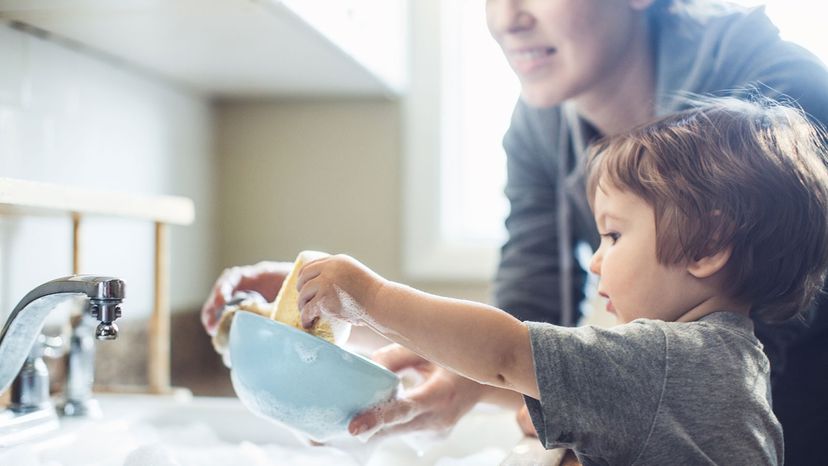\”
 \”After you or your loved ones recover from a cold or other illness, it\’s important to wash and sanitize all the utensils used. RyanJLane/Getty Images
\”After you or your loved ones recover from a cold or other illness, it\’s important to wash and sanitize all the utensils used. RyanJLane/Getty Images
The cough, sniffles and general malaise have finally subsided. Although the hard part\’s definitely over, you still have some work to do to make sure that the germs are totally banished from your house. This is especially important if you live with other people, who almost definitely wish to avoid a sniffly, sneezy fate.
"If you\’re sick, it does make sense to steer clear of household members as much as you can, though a strict quarantine is likely not necessary," says Dr. Stacey Rose, assistant professor of medicine (infectious diseases) at Baylor College of Medicine in Houston in an email. "It should also be emphasized that [just] as important as household quarantine is making sure that you stay home from work or school when you are ill to prevent spread to others."
Ideally, you have the wherewithal to stop the spread of germs by practicing excellent hygiene before, during and after your illness. Simple steps like covering your mouth when you cough, using a tissue when you sneeze and frequent, thorough hand-washing are ultra-important and more effective than you may realize.
"Different illnesses can be spread slightly differently," Rose explains. "Some viruses are passed through the air or via respiratory droplets – meaning if I cough and you inhale the air near me, you can become infected. Other illnesses are passed through shared secretions – such as if I drink from a glass and then you drink from the same glass."
So here are some actions you can teak to keep the cold or flu viruses from respreading in the home.
1. Practice Good Hand-Washing — Really
"Hand-washing is the single most important measure for preventing the spread of infection," says Rose. Indeed, hand-washing can reduce the incidence of respiratory infection by 16-21 percent. And there are a number of "key moments" in which hand-washing is exceptionally important, such as during the food preparation process, when taking care of a sick person, after using the toilet, after blowing your nose/coughing/sneezing, and so on.
Unfortunately, although hand-washing isn\’t hard, most of us cut corners when doing it. To make it effective, the Centers for Disease Control and Prevention (CDC) says to do the following:
- Wet hands with clean, running water. Temperature doesn\’t matter.
- Apply soap and work up a lather, making sure to include the areas between your fingers, under your nails and the backs of your hands. Scrub for a minimum of 20 seconds (about the amount of time it takes to sing "Happy Birthday" twice).
- Rinse well under clean water, then either air dry your hands or use a clean towel.
2. Clean Hard Surfaces
Once the wave of nasty has passed you still have to take steps to prevent anyone else in the house (or visitors) from getting sick, or from having a recurrence yourself. The flu virus can survive on certain hard surfaces, like light switches and stainless steel, for up to 48 hours. Other types of viruses, like the stomach-lurching Norovirus, are much hardier, hanging around waiting to cause havoc for up to a couple of weeks!
To treat hard surfaces, like countertops, door handles and the kitchen table you can either use a store-bought disinfectant or diluted bleach, according to The Spruce cleaning expert Mary Marlowe Leverette. Spray the surface and allow to sit for three minutes. Then wipe away the solution (and hopefully all germs) with a clean, damp cloth. Run any kitchen utensils used by the sick person through the dishwasher on high heat before they enter back into household rotation.
3. Don\’t Forget the Bathroom
The bathroom is another particularly critical area to sanitize, especially when a stomach bug is involved. During the illness, consider having the sick person use paper towels, or at least change out hand towels every day (and make sure not to use theirs).
Once everyone\’s healthy again immediately wash bath rugs, towels and hand towels in hot water, and dry them on high heat. Periodically during and after the illness you should clean highly susceptible bathroom areas, like the toilet lid, seat and handle, the floor around the toilet, shower and sink handles, door knobs and light switches.
One common culprit for reinfection is something that\’s supposed to keep you clean and healthy, but in this case can backfire — the toothbrush. So be sure to toss that out once symptoms have subsided and disinfect the holder thoroughly, as well.
4. … Or the Bedroom
As soon as possible after illness, Leverette says to wash the bed linens, as well as any pajamas or stuffed animals that were in close proximity to the ill individual. And clean off any other commonly used items, like the television remote control, books and bedside table items.
Now That\’s Interesting
Ever wondered how two people can have the same cold, but one person gets much sicker than the other? It turns out, there are many factors that affect how a person manifests infection. "This mostly has to do with one\’s immune system," Dr. Rose explains. "Children and adults tend to exhibit illnesses differently; older adults generally have a weakened immune system, relative to younger adults or children, so they may become more ill when infected with a respiratory virus."










